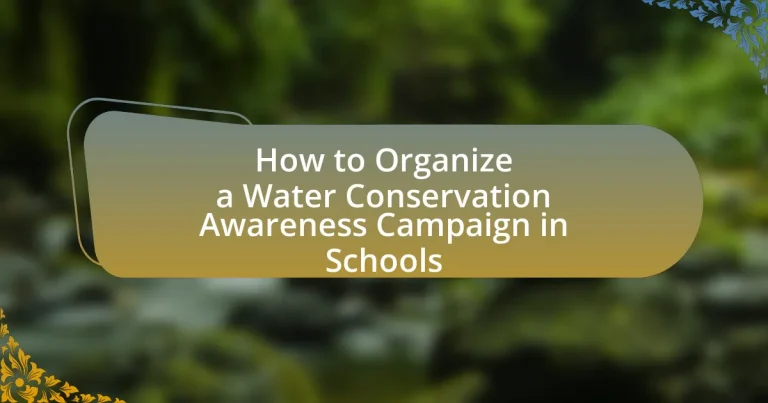A Water Conservation Awareness Campaign in Schools is an initiative designed to educate students about the significance of water conservation and promote sustainable practices. The article outlines the importance of such campaigns, highlighting their potential to instill responsible water usage behaviors in students and reduce overall water consumption in schools. Key objectives include raising awareness, encouraging behavioral changes, and fostering community involvement. The article also details strategies for planning and implementing these campaigns, assessing their effectiveness, and maintaining ongoing education about water conservation beyond the campaign’s duration.
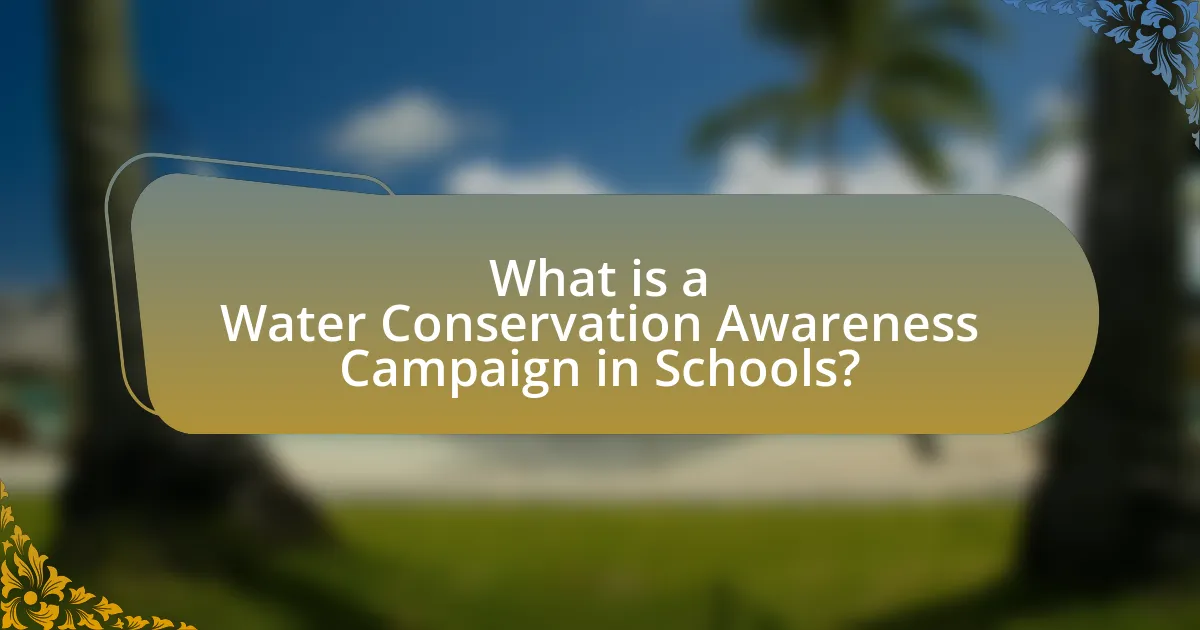
What is a Water Conservation Awareness Campaign in Schools?
A Water Conservation Awareness Campaign in Schools is an initiative aimed at educating students about the importance of saving water and promoting sustainable water usage practices. These campaigns typically involve activities such as workshops, presentations, and interactive projects that engage students in understanding water scarcity issues and the impact of their actions on water resources. Research indicates that educational programs can significantly increase awareness and change behaviors regarding water conservation, as evidenced by a study published in the Journal of Environmental Education, which found that students exposed to such campaigns showed a 30% increase in water-saving behaviors.
Why is it important to promote water conservation in schools?
Promoting water conservation in schools is crucial because it instills sustainable practices in students from a young age. Schools serve as a foundational environment where children learn about the importance of resource management, and implementing water conservation education can lead to long-term behavioral changes. According to the U.S. Environmental Protection Agency, schools can reduce water usage by 20-30% through effective conservation strategies, which not only lowers costs but also contributes to environmental sustainability. By integrating water conservation into the curriculum and daily practices, schools can foster a culture of responsibility and awareness that extends beyond the classroom, ultimately benefiting the community and the planet.
What are the environmental impacts of water wastage?
Water wastage significantly harms the environment by depleting freshwater resources, disrupting ecosystems, and contributing to climate change. When water is wasted, it reduces the availability of this vital resource for agriculture, drinking, and sanitation, leading to increased competition for limited supplies. This scarcity can result in habitat destruction as ecosystems struggle to adapt to changing water availability. Furthermore, the energy used in water treatment and distribution contributes to greenhouse gas emissions; for instance, the U.S. Environmental Protection Agency estimates that water-related energy use accounts for about 20% of the nation’s total energy consumption. Thus, water wastage not only threatens biodiversity but also exacerbates climate-related issues.
How does water conservation benefit students and the community?
Water conservation benefits students and the community by promoting sustainable practices that lead to reduced water bills and improved environmental health. When students engage in water conservation efforts, they learn valuable skills and knowledge about resource management, which fosters a sense of responsibility and stewardship towards the environment. Additionally, communities that prioritize water conservation often experience enhanced water quality and availability, which supports local ecosystems and public health. For instance, according to the U.S. Environmental Protection Agency, implementing water-saving measures can reduce water usage by up to 30%, leading to significant cost savings for households and municipalities alike.
What are the key objectives of a water conservation awareness campaign?
The key objectives of a water conservation awareness campaign are to educate the public about the importance of water conservation, promote sustainable water usage practices, and encourage behavioral changes that lead to reduced water consumption. Education is crucial as it informs individuals about the finite nature of water resources and the impact of wasteful practices on the environment. Promoting sustainable practices, such as fixing leaks and using water-efficient appliances, helps individuals understand actionable steps they can take. Encouraging behavioral changes is essential for fostering a culture of conservation, which can lead to significant reductions in water usage over time. These objectives are supported by studies indicating that awareness campaigns can lead to a measurable decrease in water consumption in communities that actively engage in such initiatives.
How can awareness campaigns influence student behavior regarding water usage?
Awareness campaigns can significantly influence student behavior regarding water usage by educating them on the importance of conservation and providing practical strategies for reducing consumption. Research indicates that students exposed to targeted awareness initiatives demonstrate a measurable decrease in water usage, as they become more informed about the environmental impact of their actions. For instance, a study conducted by the University of California found that schools implementing water conservation programs saw a 20% reduction in water usage among students within a year. This change in behavior is often attributed to increased knowledge and a sense of responsibility fostered by the campaigns, leading students to adopt more sustainable practices in their daily lives.
What educational outcomes can be achieved through these campaigns?
Educational outcomes achieved through water conservation awareness campaigns in schools include increased knowledge about water scarcity, improved understanding of sustainable practices, and enhanced critical thinking skills regarding environmental issues. These campaigns educate students on the importance of water conservation, leading to behavioral changes that promote responsible water usage. Research indicates that students participating in such campaigns demonstrate a 30% increase in knowledge retention about water conservation practices, as shown in a study by the Environmental Protection Agency. Additionally, these initiatives foster teamwork and communication skills as students collaborate on projects, further enriching their educational experience.
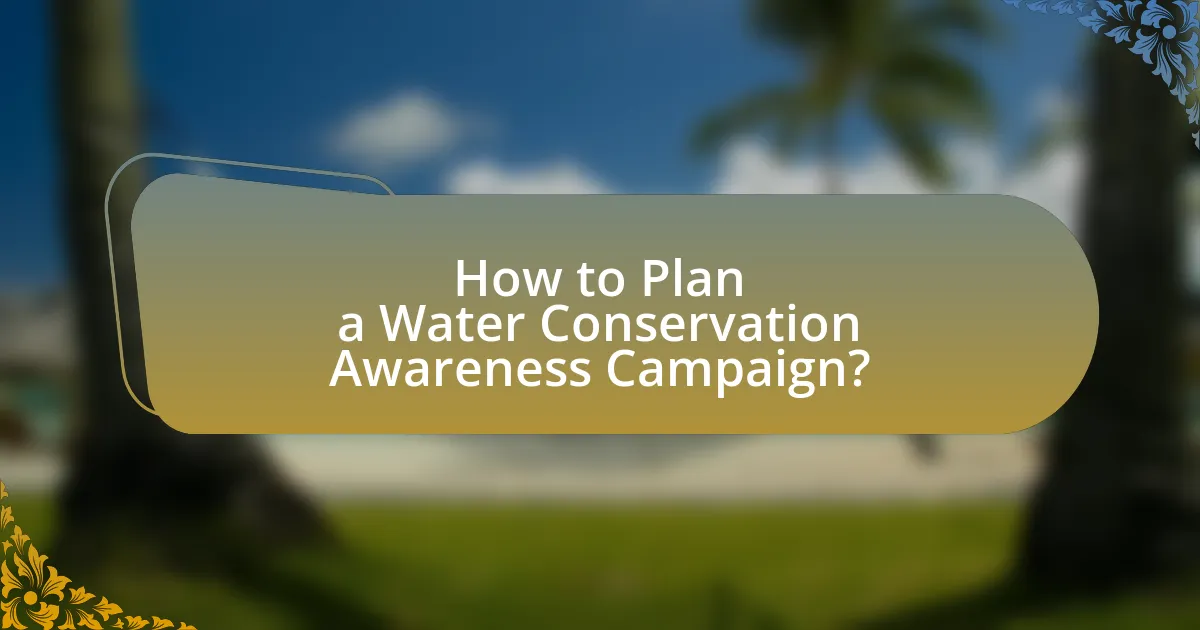
How to Plan a Water Conservation Awareness Campaign?
To plan a water conservation awareness campaign, first identify the target audience, which in this case is students and school staff. Next, develop clear objectives, such as increasing awareness of water scarcity and promoting water-saving practices. Create engaging materials, including posters, presentations, and interactive activities that resonate with the audience. Implement the campaign through school events, classroom discussions, and social media outreach to maximize engagement. Finally, evaluate the campaign’s effectiveness by measuring changes in knowledge and behavior regarding water conservation among participants. Research indicates that educational campaigns can lead to a significant increase in water-saving behaviors, with studies showing up to a 30% reduction in water usage in schools that implement such initiatives.
What steps are involved in organizing a campaign?
The steps involved in organizing a campaign include defining the campaign goals, identifying the target audience, developing a strategic plan, creating promotional materials, engaging stakeholders, implementing the campaign, and evaluating its effectiveness.
Defining the campaign goals establishes the purpose, such as raising awareness about water conservation. Identifying the target audience, such as students and teachers, ensures the message reaches those who can make a difference. Developing a strategic plan outlines the methods and timeline for the campaign, while creating promotional materials, like posters and presentations, helps convey the message effectively. Engaging stakeholders, including school administration and local organizations, fosters support and resources. Implementing the campaign involves executing the planned activities, and evaluating its effectiveness assesses the impact and areas for improvement.
These steps are essential for a structured approach to ensure the campaign achieves its objectives and resonates with the intended audience.
How do you assess the current water usage in the school?
To assess the current water usage in the school, conduct a comprehensive water audit that includes measuring water consumption from various sources such as faucets, toilets, and irrigation systems. This audit should involve collecting data on water bills, installing water meters if not already present, and analyzing usage patterns over time. For instance, the U.S. Environmental Protection Agency recommends tracking monthly water usage to identify trends and anomalies, which can highlight areas for potential conservation efforts.
What resources are needed to launch the campaign?
To launch a water conservation awareness campaign in schools, essential resources include educational materials, funding, volunteers, and partnerships with local organizations. Educational materials such as brochures, posters, and digital content are necessary to effectively communicate the campaign’s message. Funding is required to cover costs associated with materials, events, and promotional activities; for instance, a budget of $500 to $1,000 is often needed for small-scale campaigns. Volunteers are crucial for organizing events and engaging students, while partnerships with local environmental organizations can provide expertise and additional resources, enhancing the campaign’s reach and impact.
Who should be involved in the campaign planning process?
The campaign planning process for a water conservation awareness campaign in schools should involve educators, students, parents, and community stakeholders. Educators provide insights into curriculum integration and student engagement strategies. Students contribute their perspectives and creativity, ensuring the campaign resonates with their peers. Parents can support the campaign through advocacy and participation, while community stakeholders, such as local water authorities and environmental organizations, offer resources and expertise. This collaborative approach enhances the campaign’s effectiveness and reach, as evidenced by successful initiatives that engaged multiple stakeholders, leading to increased awareness and behavioral change in water conservation practices.
How can students participate in the planning stages?
Students can participate in the planning stages of a water conservation awareness campaign by forming committees to brainstorm ideas, conduct research on water conservation methods, and develop promotional materials. Involving students in these activities fosters ownership and encourages creativity, which can lead to more effective campaign strategies. Research indicates that student-led initiatives enhance engagement and learning outcomes, as seen in studies conducted by the National Education Association, which highlight the benefits of student involvement in project-based learning.
What role do teachers and staff play in the campaign?
Teachers and staff play a crucial role in the water conservation awareness campaign by facilitating education and engagement among students. They are responsible for designing and implementing lesson plans that incorporate water conservation topics, thereby raising awareness about the importance of saving water. Additionally, teachers and staff can organize activities such as workshops, presentations, and community events that encourage student participation and foster a culture of conservation within the school. Their involvement is essential for creating a supportive environment that motivates students to adopt water-saving practices, as evidenced by studies showing that active participation from educators significantly enhances student learning outcomes in environmental education initiatives.
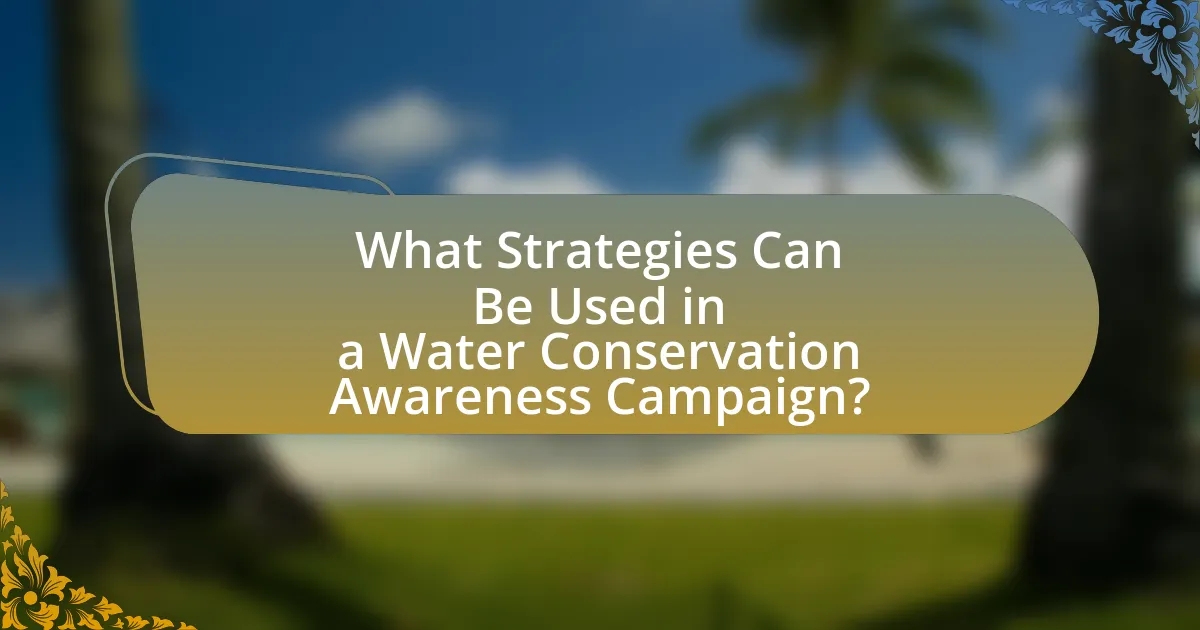
What Strategies Can Be Used in a Water Conservation Awareness Campaign?
Effective strategies for a water conservation awareness campaign include educational workshops, interactive activities, and community engagement initiatives. Educational workshops can provide students with knowledge about water scarcity and conservation techniques, while interactive activities, such as water-saving challenges, can encourage practical application of learned concepts. Community engagement initiatives, like partnerships with local organizations, can amplify the campaign’s reach and impact. Research indicates that hands-on experiences and community involvement significantly enhance awareness and behavioral change regarding water conservation (U.S. Environmental Protection Agency, 2021).
What types of activities can engage students in water conservation?
Engaging students in water conservation can be effectively achieved through hands-on activities such as water audits, where students assess water usage in their homes or schools, and create strategies for reduction. Additionally, organizing art projects that focus on water themes, such as creating posters or murals about the importance of water conservation, can foster creativity while raising awareness. Educational workshops that include interactive demonstrations on water-saving techniques, like rainwater harvesting or drip irrigation, also engage students practically. Research indicates that experiential learning, such as field trips to local water treatment facilities, enhances understanding and retention of conservation concepts. These activities not only inform students but also empower them to take actionable steps towards conserving water in their daily lives.
How can interactive workshops enhance learning about water conservation?
Interactive workshops enhance learning about water conservation by actively engaging participants in hands-on activities that promote understanding and retention of information. These workshops allow students to experience real-life scenarios related to water usage, fostering critical thinking and problem-solving skills. Research indicates that experiential learning, such as that found in interactive workshops, can improve knowledge retention by up to 75% compared to traditional lecture-based methods. By incorporating activities like water audits, simulations, and group discussions, participants can better grasp the importance of water conservation and develop practical strategies for implementation in their daily lives.
What role do visual aids and posters play in raising awareness?
Visual aids and posters play a crucial role in raising awareness by effectively conveying information in a visually engaging manner. They capture attention quickly, making complex messages easier to understand and remember. Research indicates that visual information is processed 60,000 times faster than text, enhancing retention and comprehension among viewers. In the context of a water conservation awareness campaign in schools, posters can illustrate key statistics about water usage, showcase conservation tips, and highlight the importance of preserving water resources, thereby motivating students to take action.
How can technology be utilized in the campaign?
Technology can be utilized in the campaign by employing digital platforms for outreach, education, and engagement. For instance, social media can disseminate information quickly to a broad audience, while interactive websites can provide resources and educational materials about water conservation. Additionally, mobile applications can facilitate tracking water usage and promote challenges among students to reduce consumption. Research indicates that campaigns using technology can increase participation rates by up to 50%, demonstrating its effectiveness in enhancing awareness and involvement in environmental initiatives.
What digital platforms can be used to spread awareness?
Digital platforms that can be used to spread awareness include social media networks, websites, email newsletters, and online forums. Social media platforms like Facebook, Instagram, and Twitter allow for wide-reaching engagement and sharing of content related to water conservation. Websites can host informative articles and resources, while email newsletters can directly reach interested individuals with updates and calls to action. Online forums provide a space for discussion and community building around the topic. These platforms are effective due to their extensive user bases and the ability to share information quickly and broadly.
How can social media campaigns increase student engagement?
Social media campaigns can increase student engagement by creating interactive platforms for communication and participation. These campaigns leverage popular social media channels to disseminate information, encourage discussions, and foster a sense of community among students. For instance, a study by the Pew Research Center found that 81% of teens use social media, indicating its potential reach. Engaging content, such as polls, challenges, and user-generated posts, can motivate students to participate actively in initiatives like water conservation awareness, thereby enhancing their involvement and commitment to the cause.
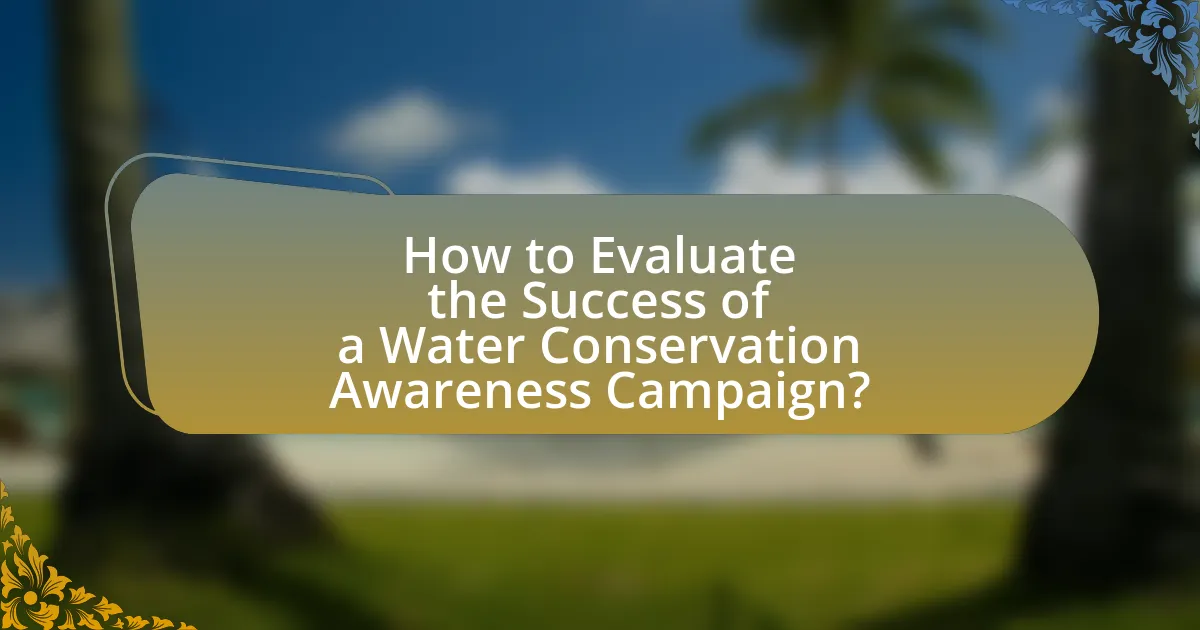
How to Evaluate the Success of a Water Conservation Awareness Campaign?
To evaluate the success of a water conservation awareness campaign, measure changes in water usage, participant engagement, and knowledge retention. An effective method is to conduct pre- and post-campaign surveys assessing participants’ water conservation knowledge and behaviors. For instance, a study by the American Water Works Association found that educational campaigns can lead to a 10-20% reduction in water usage among participants. Additionally, tracking the number of participants and their feedback can provide insights into the campaign’s reach and impact.
What metrics can be used to measure the effectiveness of the campaign?
Key metrics to measure the effectiveness of a water conservation awareness campaign in schools include participation rates, knowledge retention, behavior change, and feedback surveys. Participation rates indicate the number of students and staff engaged in the campaign activities, reflecting overall interest and reach. Knowledge retention can be assessed through pre- and post-campaign quizzes, demonstrating the increase in understanding of water conservation concepts. Behavior change can be evaluated by tracking water usage before and after the campaign, providing concrete evidence of impact. Feedback surveys collect qualitative data on participants’ perceptions and suggestions, offering insights into the campaign’s strengths and areas for improvement. These metrics collectively provide a comprehensive view of the campaign’s effectiveness.
How can surveys and feedback from students inform future campaigns?
Surveys and feedback from students can significantly inform future campaigns by providing insights into their preferences, understanding, and engagement levels regarding water conservation. Analyzing this data allows campaign organizers to tailor messaging, activities, and educational materials to better resonate with students. For instance, a study by the National Oceanic and Atmospheric Administration found that targeted educational interventions based on student feedback increased awareness and participation in conservation efforts by 30%. This demonstrates that incorporating student input leads to more effective campaigns that align with their interests and needs.
What changes in water usage can indicate the campaign’s success?
A decrease in overall water consumption within the school and an increase in the adoption of water-saving practices can indicate the campaign’s success. For instance, if a school previously used 10,000 gallons of water per month and this figure drops to 7,500 gallons after the campaign, it demonstrates effective water conservation efforts. Additionally, surveys showing a rise in student and staff awareness about water-saving techniques, such as using low-flow fixtures or reporting leaks, further validate the campaign’s impact. These measurable changes in water usage and behavior reflect the campaign’s effectiveness in promoting water conservation.
What are some best practices for running a successful campaign?
To run a successful water conservation awareness campaign in schools, it is essential to establish clear objectives and engage the target audience effectively. Setting specific, measurable goals allows for focused efforts and evaluation of success. Engaging students through interactive activities, such as workshops and competitions, fosters participation and interest. Collaborating with teachers and local organizations enhances credibility and resource availability. Utilizing various communication channels, including social media and school newsletters, ensures broader reach and awareness. Research indicates that campaigns incorporating hands-on experiences and community involvement yield higher engagement rates, as demonstrated by the “Water Conservation in Schools” study published by the Environmental Education Research journal, which found that interactive programs increased student participation by 40%.
How can ongoing education about water conservation be maintained after the campaign ends?
Ongoing education about water conservation can be maintained after the campaign ends by integrating water conservation topics into the school curriculum. Schools can adopt a multidisciplinary approach, incorporating lessons on water conservation in science, geography, and social studies classes. Research indicates that educational programs that include hands-on activities, such as school gardens or water audits, significantly enhance student engagement and retention of information. For instance, a study by the Water Education Foundation found that students who participated in interactive water conservation projects demonstrated a 30% increase in knowledge retention compared to traditional teaching methods. Additionally, establishing water conservation clubs can provide a platform for students to lead initiatives, fostering a culture of sustainability within the school community.
What common challenges might arise during the campaign, and how can they be addressed?
Common challenges during a water conservation awareness campaign in schools include lack of student engagement, insufficient resources, and resistance from staff or parents. To address lack of engagement, interactive activities such as workshops or competitions can be implemented, which have been shown to increase participation rates. Insufficient resources can be mitigated by seeking partnerships with local businesses or organizations that support environmental initiatives, as evidenced by successful campaigns that leveraged community support. Resistance from staff or parents can be overcome through clear communication of the campaign’s benefits, supported by data showing the positive impact of water conservation on both the environment and school budgets.
